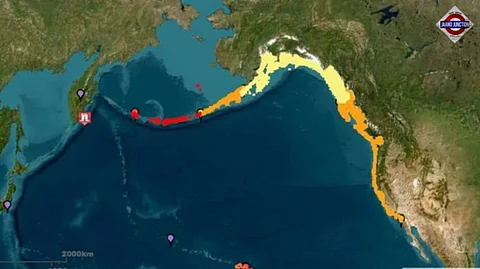

The Pacific region is on tsunami alert after a massive 8.8-magnitude earthquake struck off Russia's far eastern coast. Alaska and Hawaii saw violent waves while other parts of the US West Coast braced for impact. While it's still unclear how big the tsunami could be, warning centres in the US have shared estimated times when the country's coasts may be hit.
Alaska's western Aleutian Islands, Kodiak, and Southeast Alaska have already witnessed the first tsunami waves.
Hawaii saw waves as tall as four feet crashing into its shores, but braced for even more violent waves. No damage has been reported yet, though the Hawaii Emergency Management Agency expected significant destruction along the coastlines. Emergency shelters in Hawaii County have been opened.
"So far, so good. There is no plan to shut off power in advance. Don't get on the road at all tonight. The airports have not yet been impacted by waves, but all flights in and out of Hawaii have been cancelled for tonight," said the Hawaii EMA.
In Washington and Oregon, also on alert, the arrival of tsunami waves is estimated to begin between 2:35 am and 2:55 am ET (12:05 pm-12:25 pm IST). The arrival in Northern California is expected to begin at 2:50 am ET (12:20 pm) and reach the San Francisco Bay around 3:40 am ET (1:10 pm), and Southern California coastlines around 4 am ET (1:30 pm).
A tsunami advisory is in effect for all coastal regions in the Bay Area and Central Coast, including San Francisco and San Pablo Bays, according to the National Weather Service in the San Francisco Bay Area. Dangerous currents and waves are possible, it has warned, urging people to stay away from the beaches and waterways until local officials say otherwise.
In a similar advisory, NSW Los Angeles said rising water levels and strong currents may affect all beach areas, especially harbours and marinas. "Tsunamis typically arrive as a series of waves, which can be dangerous for many hours after the first wave," it warned.
The Indian mission in San Francisco has advised Indians in California and other states on the US West Coast to avoid coastal areas, move to higher grounds if a tsunami warning is issued, follow local alerts, and prepare for emergencies.
